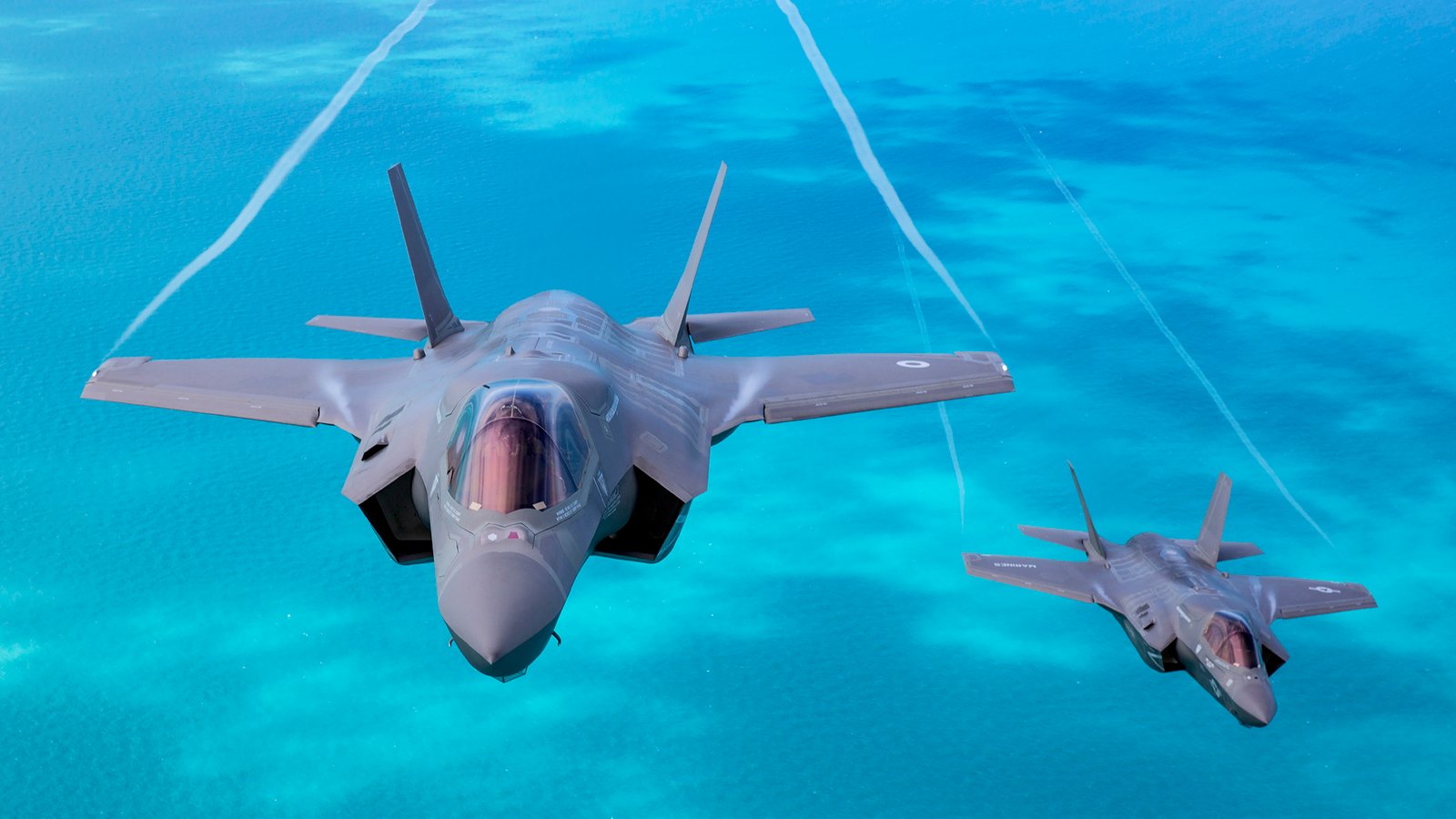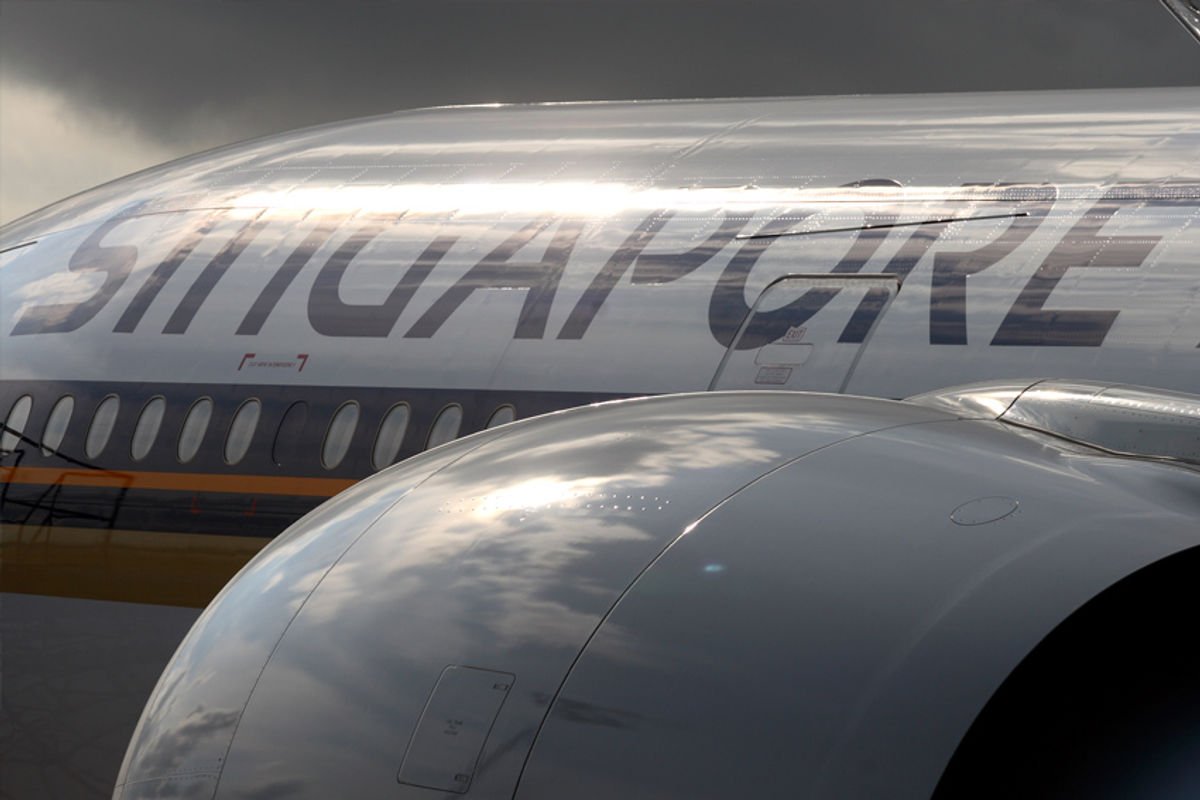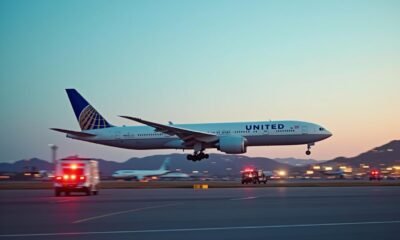Flight Buzz
U.S. and UK Are Developing Collision Avoidance Tech for the F-35

The Collision Avoidance Manual Deconfliction is being tested on the F-35 at Edwards AFB and is intended to reduce the risk of midair collision with civilian and military aircraft.
The United States and the United Kingdom are jointly developing a new safety system for the F-35 Lightning II, aimed at avoiding midair collisions between military and civilian aircraft. The development was first reported by Aviation Week few days after an incident between a U.S. Air Force B-52 Stratofortress and a Delta Embraer E175 made the headlines, with the latter performing an “aggressive go-around” to avoid the bomber.
According to Kevin Price, an Air Force Research Laboratory (AFRL) program manager quoted by Aviation Week, the new “Collision Avoidance Manual Deconfliction” (CAMD) system is currently in testing on the F-35 test fleet at Edwards Air Force Base, California. The development of the CAMD technology is not the result of recent events, as it has been in the works for several years.
Collision Avoidance Manual Deconfliction
According to Price, the system was initially an unfunded AFRL proposal. Later on, the UK Ministry of Defense and the AFRL agreed to share the development costs, with each paying for half.
The involvement of the UK should not be surprising, as the country has been working to make safer the coexistence of civilian and military traffic in the same airspace. For an instance, the UK was one of the first countries to equip all its military aircraft with ADS-B (Automatic Dependent Surveillance – Broadcast) and is adopting technologies on the Protector RG1 unmanned aircraft to safely fly it in non-segregated airspace without compromising safety.
“The whole reason that the UK came to us for this collaborative program was they wanted to mitigate the risk of an F-35 running into an airliner or commercial traffic in the UK,” Price explained.
Civilian aircraft, especially airliners and commercial aviation, are equipped with Traffic Collision Avoidance System (TCAS), which monitors the airspace around the aircraft for transponder signals, detecting potential threats and providing pilots with alerts and instructions to avoid collisions. A similar system is not yet available for military aircraft, but CAMD aims to change that.
According to Price, who presented the system during a teleconference at the Experimental Aircraft Association’s AirVenture convention in Oshkosh, the technology derives from an automatic collision avoidance system that AFRL is developing to prevent midair collisions between military aircraft.
The military technology is based on a datalink with the requirement of “a positioning update rate of at least 20 times per second, but ideally as high as 40.” The datalink must be present on both the aircraft considered in a collision scenario for the technology to work.
“It can work well for fighter aircraft,” Price said. “We can be 500 ft. of each other and doing some extremely aggressive maneuvering, and the system will work and not engage in that situation unless the aircraft are going to hit.”
However, the automatic air collision avoidance system only works if both the aircraft involved in the potential midair are military aircraft. The problem is that there isn’t a common data link shared by both civilian and military aircraft, and the CAMD team is looking to overcome this obstacle.
Price is confident that the CAMD technology will work, although there are no details yet about the possible solutions to the problem. Also, Price mentioned that the F-35 Joint Program Office has not yet a timeline for the integration of CAMD on the F-35 as part of the Block 4 upgrade.
“They’ve deferred it from the Block 4 update,” said Price. “So now, that said, when they did that, the good news is they didn’t vote it off the island. They were throwing things out left and right, and we came really close to seeing the program like completely just removed from F-35 consideration.”
While the timeline is not yet clear, the team is developing and testing the technology to be ready when the time comes. However, getting there was not straightforward.
“Why that was problematic is that if they didn’t make it a requirement on the F-35 then they wouldn’t let us have access to flight test aircraft, or to the production team at Lockheed, or the test stands at Lockheed,” explained Price. “So we really were fighting them, frankly, to make sure they did not remove it as a requirement.”
Recent incidents
As mentioned earlier, on July 18, 2025, a Delta Embraer E175, operated by SkyWest Airlines as flight DL3788 from Minneapolis to Minot, North Dakota, was forced to perform an “aggressive go-around” to avoid a U.S. Air Force B-52 Stratofortress operating in the vicinity of Minot. The incident occurred during the E175’s final approach to Minot International Airport, which shares airspace with Minot Air Force Base, home to the 5th Bomb Wing equipped with B-52 bombers.
The crew later explained to the passengers that the maneuver was necessary to avoid a B-52 that appeared on the approach path with no advance notice. The U.S. Air Force confirmed that the B-52 was performing a flyover at the North Dakota State Fairgrounds.
The service said in a statement that the flyover was planned in advance and approved by the Federal Aviation Administration, and the bomber was in contact will all air traffic control agencies. During the potential collision, the bomber was communicating with Minot International Airport’s tower, which however did not advise of the inbound commercial aircraft. Both the FAA and the Air Force are investigating the incident.
Another instance was the midair collision over the Potomac River, on Jan. 29, 2025, between a U.S. Army UH-60L Black Hawk and a PSA Airlines CRJ700 regional airliner, flying as Flight 5342. The accident resulted in the loss of all 67 individuals on board both aircraft, marking one of the deadliest aviation incidents in recent U.S. history.
The helicopter was conducting a VFR (visual flight rule) mission for the pilot’s annual standardization evaluation, utilizing NVGs (Night Vision Goggles). PSA Airlines Flight 5342, operating as a scheduled domestic passenger flight from Wichita Dwight D. Eisenhower National Airport (ICT) in Kansas to DCA, was on visual approach to runway 33.
The Black Hawk was traveling south along the Potomac River, and the CRJ700 was approaching from the south. The Black Hawk crew confirmed visual contact with the airliner and requested visual separation, with the controller later instructing the UH-60L to pass behind the CRJ700.
The collision, which was filmed from several different points of view, occurred at 8:47:59 PM, at an altitude of about 300 feet, as Flight 5342 was on final approach to runway 33. The collision left no survivors.
Flight Buzz
Singapore Airlines reports ‘robust demand’

Singapore Airlines (SIA) carried a record number of passengers between April and June thanks to “robust demand” for travel.
The Asian carrier, which also owns budget brand Scoot, saw passenger numbers increase by 6.9 per cent to 10.3 million for the first quarter of its financial year, while revenue went up by 1.5 per cent to SG$4.8 billion (€3.2 billion).
Despite this growth in traffic and revenue, SIA’s passenger yields fell by 2.9 per cent year-on-year “amid heightened competition as more airlines continue to add capacity”.
The group added that demand for flights “remains healthy” in the current quarter across most global regions.
“However, the global airline industry continues to face a volatile operating environment, with challenges ranging from geopolitical developments and macroeconomic fluctuations to changing market dynamics and supply chain constraints,” said SIA in its announcement. “The group will be agile and proactive in responding to changes in demand patterns.”
SIA’s proposed commercial joint venture with Malaysia Airlines has just received conditional approval from the Competition and Consumer Commission of Singapore. The deal will allow the two airlines to collaborate on sales and marketing, as well as expand codeshare flights.
Meanwhile, the group said it would “ramp up” capacity from Singapore to several regional destinations, such as Malaysia, Sri Lanka, Thailand and the Philippines, with the impending closure of budget rival Jetstar Asia on 31 July.
Scoot has also continued to add long-haul services, including a route between Singapore and Vienna, which launched in June.
SIA’s operating profit for the quarter fell by 13.8 per cent year-on-year to SG$405 million (€270 million). This was due to higher inflation on non-fuel costs and accounting for losses from its 25.1 per cent stake in Air India Group, which SIA acquired following Air India’s merger with Vistara earlier this year.
Flight Buzz
American, Delta, Frontier, JetBlue, and PSA, Cancel Over 190 Flights, Disrupting Travel Across US Routes Including Chicago, Washington, Miami, Tampa, New York, and More

Monday, July 28, 2025
American Airlines, PSA Airlines, Delta Air Lines, Frontier, and JetBlue have collectively canceled over 190 flights, causing widespread travel disruption across the US. Routes including Chicago to Washington, Miami to Newark, Tampa to New York, and several others have been impacted by the cancellations, primarily due to adverse weather conditions. American Airlines accounted for the majority of the cancellations with 96 flights, while PSA Airlines, Delta, Frontier, and JetBlue also experienced significant disruptions. Passengers are urged to check their flight statuses regularly and explore alternative routes as airlines work to accommodate the affected travelers.
American Airlines led the cancellations with 96 flights canceled, accounting for 2% of its total operations. Additionally, 155 flights were delayed, representing 4% of their scheduled flights. Major affected routes included Chicago to Washington, Miami to Newark, and Tampa to New York. PSA Airlines, a regional carrier for American Airlines, canceled 43 flights, making up 5% of its flights, with 24 flights delayed, which is 3% of its scheduled operations. Key disrupted routes included Charlotte to Richmond and Reagan National to Buffalo. Delta Air Lines experienced 25 cancellations, equaling 2% of its total flights, with 15 delays, representing 2% of its operations. Major affected routes included Atlanta to New York, Miami to LaGuardia, and Hartsfield-Jackson to Baltimore. Frontier Airlines had 15 cancellations, making up 0% of its scheduled flights, and 105 delays, which is 2% of its flights. Key routes impacted by Frontier’s cancellations included Washington Dulles to Atlanta and Baltimore to Orlando. Finally, JetBlue Airways reported 14 cancellations, constituting 1% of its total flights, and 67 delays, accounting for 6% of its operations. Major routes disrupted by JetBlue included New York to Tampa, New York to Orlando, and Fort Lauderdale to New York. These disruptions have significantly affected travel across key US routes.
Overview of Cancellations
American Airlines has been hit particularly hard, with 96 flights canceled. Affected routes include popular connections such as Chicago to Washington, Miami to Newark, and Tampa to New York. The airline’s significant number of cancellations has left passengers stranded at airports across the country, particularly on routes serving high-traffic cities. Other disrupted routes include Philadelphia to Dallas and Washington to Miami, further compounding the challenges for travelers.
PSA Airlines, a regional carrier for American Airlines, also faced substantial cancellations, with 43 flights canceled. Key routes impacted by PSA’s cancellations include Charlotte to Richmond, Reagan National to Buffalo, and Reagan National to Cleveland. This has added more stress to an already challenging travel experience, as travelers try to adjust to the changes with limited rebooking options.
Delta Air Lines followed suit with 25 canceled flights, disrupting routes like Atlanta to New York, Miami to LaGuardia, and Hartsfield-Jackson to Baltimore. Other affected routes include Detroit to Seattle and Washington to Atlanta, causing major delays and re-routing headaches for passengers. The airline has expressed its efforts to accommodate those affected, but the extensive cancellations have led to increased frustration for many travelers.
Frontier Airlines, known for its low-cost fares, has canceled 15 flights. These cancellations have affected routes such as Washington Dulles to Atlanta, Baltimore to Orlando, and Miami to Washington Dulles. Frontier’s cancellations are particularly significant for passengers hoping to take advantage of its affordable fares, leaving many seeking alternative travel options at the last minute.
JetBlue Airways also experienced flight cancellations, with 14 flights impacted. Key routes affected include New York to Tampa, New York to Orlando, and Fort Lauderdale to New York. The airline’s cancellation of these routes has caused a ripple effect, creating delays and causing passengers to scramble for rebooking options, especially during peak travel times.
Key Routes Affected
The cancellations have disrupted several major domestic routes across the US. Some of the most affected include:
- Chicago to Washington: A critical route for both business and leisure travelers, now facing significant delays and cancellations.
- Miami to Newark: Another key route, particularly for commuters, now facing long delays and limited alternative flights.
- Tampa to New York: A heavily traveled route now experiencing considerable disruption due to flight cancellations.
- Washington to Miami: Frequent disruptions on this route, a key connection for many, are leaving passengers looking for alternative ways to reach their destinations.
- Philadelphia to Dallas: This route has also faced cancellations, with a significant number of travelers now affected by delays and limited rebooking options.
Travel Disruption Across the US
With more than 190 flight cancellations across these major US airlines, travelers have been left scrambling to find alternative routes, leading to crowded airports, long delays, and an increase in travel frustration. The cancellations are primarily attributed to inclement weather conditions that have impacted flight operations, making it difficult for airlines to maintain normal schedules.
Travelers are advised to check the status of their flights before heading to the airport, as delays and cancellations may continue for the next few days. Airlines have promised to do their best to accommodate affected passengers, offering rebooking options, though availability remains limited during this period of heightened disruption.
Tips for Affected Travelers
- Stay Updated: Always check your airline’s website or app for real-time flight status updates. Most airlines now offer SMS alerts and email notifications about delays and cancellations.
- Consider Alternative Routes: If your flight has been canceled, consider alternative airports or routes. For instance, if you were flying into LaGuardia, check for flights to Newark or JFK.
- Travel Insurance: For those with flexible travel plans, consider investing in travel insurance, especially when adverse weather conditions are a factor.
- Be Prepared for Delays: With significant cancellations, delays are likely to follow. Arriving early and packing essentials like snacks and entertainment can make waiting times more manageable.
American Airlines, PSA Airlines, Delta Air Lines, Frontier, and JetBlue have canceled over 190 flights, disrupting travel across key US routes such as Chicago to Washington and Miami to Newark. The cancellations, primarily caused by adverse weather conditions, have left many passengers stranded and scrambling for alternatives.
The current wave of flight cancellations and delays is a reminder of how unpredictable weather and operational issues can affect air travel. With over 190 flights canceled across major US airlines and routes, travelers are urged to be patient and proactive in seeking updates and rebooking options. As airlines work to clear backlogs and return to normal service, it’s recommended that passengers stay vigilant and remain flexible with their travel plans.
Flight Buzz
Wizz Air Shifts Focus: UK Flights to Budapest Discontinued, New Routes to Spain and Romania Announced, What Travelers Must Know

Monday, July 28, 2025
Wizz Air, the budget carrier which has forged a reputation for offering cheap flights across Europe, has announced a major overhaul of its UK flight network. “The decision by easyJet to suspend its services to Budapest from Liverpool and Glasgow has nothing to do with the launch or how well the route is going. The decision, which will come into place in October 2025, has left citybreakers in the UK wondering where to turn for the affordable flights to the Hungarian capital they’ve come to depend on from the airline.
The Liverpool-Budapest service – introduced in 2016 – will operate for a final time on October 24, while the Glasgow-Budapest service, introduced in 2023 as a replacement for the former Edinburgh route, will stop on October 25. These are both disappointing cancellations for people (since who wouldn’t love the offer of cheap, direct flights to Hungary for the hockey whenever they wanted), but Wizz Air is already returning its attention to new travel for passengers flying from the UK.
New Horizons: Wizz Air Announces Exciting New Routes
For UK travelers looking for new destinations, Wizz Air is set to launch several fresh routes, particularly to Spain and Romania, starting in 2026. These new services are part of the airline’s effort to respond to changing demand and adapt to passenger preferences. Here’s what’s in store:
- London Gatwick to Wroclaw: This month, Wizz Air began flying four times a week from London Gatwick to Wroclaw, Poland. This route is expected to appeal to travelers seeking an affordable alternative to Poland’s more popular destinations like Krakow.
- London Luton to Spain: Starting March 2026, Wizz Air will introduce flights to five Spanish cities: Bilbao, Barcelona, Madrid, Valencia, and Seville. These new services will be a welcomed addition for UK-based sun-seekers and culture lovers planning trips to Spain.
- Birmingham to Sibiu: For the more adventurous, Wizz Air will begin flying to Sibiu, Romania, from October 2025. Located in the heart of Romania, Sibiu offers travelers a chance to explore a lesser-known, historic city in the Transylvanian region, offering charm and a more relaxed pace than Romania’s busier tourist hubs.
These new routes highlight Wizz Air’s ambition to expand its footprint in key European markets while also addressing demand for more destinations in Central and Eastern Europe.
Strategic Shift: Why Budapest Flights Are Being Cut
So, why is Wizz Air discontinuing its Budapest routes from Liverpool and Glasgow? According to a Wizz Air spokesperson, the airline regularly reviews the performance of its routes to ensure that it can offer the most popular destinations at the best possible prices. Routes that are not performing up to expectations may be cut, while more lucrative ones—like those to Spain and Romania—are prioritized.
CEO József Váradi shared a broader strategic vision for the airline, noting that they have been underinvesting in this market over the last few years. Now we can go back to the full spirit of continuously exploiting the market. This statement indicates that Wizz Air sees great potential in Central and Eastern Europe and plans to reallocate resources accordingly.
It’s worth noting that while Ryanair will still offer direct flights from Liverpool to Budapest, the discontinuation of Wizz Air’s flights will likely force some travelers to adjust their plans. However, for those interested in affordable travel to Spain or Romania, the new Wizz Air routes could be the perfect opportunity to explore new destinations at low fares.
What Does This Mean for Travelers?
Passengers in Liverpool or Glasgow that were going to fly to Budapest will also need to look at alternative routes as well, for example on to Edinburgh or London. You can also try your luck with Ryanair but the move of Wizz Air to other areas, mainly Spain and Romania, is not going to make happy anyone who regularly flies to Budapest.
The upside, though, is that with Wizz Air’s switch to growth paths that include cities such as Bilbao, Madrid, or Sibiu, ever-more-interesting destinations are becoming alternatives for anyone who is budget-conscious. Whether you want to sun yourself in Spain, or uncover Romania’s rich history and culture, Wizz Air is ensuring it will still be among your top options for European travel on a tight budget.
Wizz Air’s Ongoing Global Adjustments
The UK flight cancellations are just one of Wizz Air’s larger restructuring actions. The airline has also said it will end its Abu Dhabi operations in September 2025, due to airspace constraints and security issues in the region. With Wizz Air tidying up its international network, it will reinvest its resources in its core business in Central and Eastern Europe, the airline’s traditional power base.
The emphasis on developing UK flights to places such as Wroclaw, Seville and Sibiu is part of this larger effort to piggyback off Wizz Air’s strong presence in main European markets. While some routes are being grounded, Wizz Air is trying to ensure low-cost travel is still within reach for its passengers throughout the continent.
-

 Brand Stories1 week ago
Brand Stories1 week agoBloom Hotels: A Modern Vision of Hospitality Redefining Travel
-

 Brand Stories2 days ago
Brand Stories2 days agoCheQin.ai sets a new standard for hotel booking with its AI capabilities: empowering travellers to bargain, choose the best, and book with clarity.
-

 Destinations & Things To Do1 week ago
Destinations & Things To Do1 week agoUntouched Destinations: Stunning Hidden Gems You Must Visit
-

 AI in Travel1 week ago
AI in Travel1 week agoAI Travel Revolution: Must-Have Guide to the Best Experience
-

 Brand Stories3 weeks ago
Brand Stories3 weeks agoVoice AI Startup ElevenLabs Plans to Add Hubs Around the World
-

 Brand Stories2 weeks ago
Brand Stories2 weeks agoHow Elon Musk’s rogue Grok chatbot became a cautionary AI tale
-

 Destinations & Things To Do2 days ago
Destinations & Things To Do2 days agoThis Hidden Beach in India Glows at Night-But Only in One Secret Season
-

 Asia Travel Pulse3 weeks ago
Asia Travel Pulse3 weeks agoLooking For Adventure In Asia? Here Are 7 Epic Destinations You Need To Experience At Least Once – Zee News
-

 AI in Travel3 weeks ago
AI in Travel3 weeks ago‘Will AI take my job?’ A trip to a Beijing fortune-telling bar to see what lies ahead | China
-

 Brand Stories3 weeks ago
Brand Stories3 weeks agoChatGPT — the last of the great romantics













You must be logged in to post a comment Login